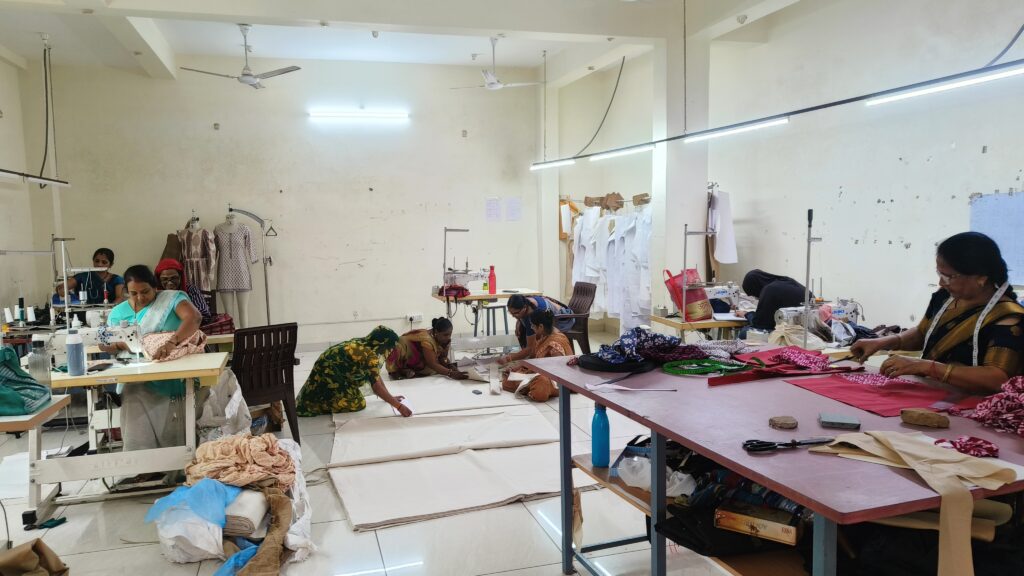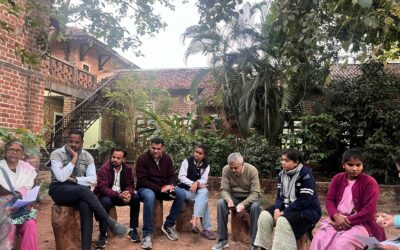It has been nine months since I started my fellowship, and I am now halfway through this journey. During my time here, I have tried to identify various issues and challenges faced by women in my field area. Most of these problems are related to family restrictions, employment difficulties, economic hardships, and more. When I look back at what the women have shared, one phrase stands out:
“Didi, ghar baithe ka koi kaam dila do,” (Translates to, sister, please help me find work I can do from home).
Like many people, I had some assumptions. I thought that these women wanted work from home because they might be restricted by their families from going outside to work. While that may be true in some cases, but in my prejudice, I overlooked an important issue in the village which should be considered way before.
With my placement as a fellow with Chaitanya WISE in Madhya Pradesh, I am working with a livelihood project named Kala Maitri with the organisation in the Maheshwar and Ujjain areas. Kala Maitri is a Women Entrepreneur Network (WEN) focused on building a collective of women running enterprises, where they take ownership and responsibility for their businesses. As part of this project, we have set up a stitching centre called Kala Kendra in the heart of Maheshwar town, which is famous for its handwoven maheshwari silk-cotton.

Hesitation
One of the main goals of Kala Maitri is to provide livelihood opportunities for women in a comfortable and flexible work environment. At Kala Kendra, there are no fixed income or strict working hours. Instead, women are paid based on the amount of work they complete in a month. Women who join Kala Maitri become members of the Silai (tailoring) WEN group and participate in decision-making within the collective. The centre also offers regular training for women who are new to the work, helping them build their skills.
While visiting nearby villages around Maheshwar, I invited all women looking for employment to join Kala Maitri. However, their preference remained to working from home opportunities only. As mentioned, in my prejudice I believed that they are not coming out of their homes because of family restrictions. But as and when I looked deeper into it, I realised that mobility to the centre from the village they were living in, was a larger issue than the restrictions.
Some Facts To Substantiate
The villages I visited were, on average, 10 kilometers away from the centre. In particular, Jalkoti, which is also a popular tourist spot in Maheshwar due to Sahastra Dhara, is 5.4 kilometers away but has no regular transport to the town. On Tuesdays, there are hourly rickshaws because of the local market, but on other days, hiring a rickshaw is expensive and impractical due to the low number of riders.
Another village, Aashapur, is 13 kilometers from Maheshwar. On the way, there is another village called Itawadi, located 6.3 kilometers from the town. The bus on this route only runs twice a day, with long gaps between trips. Other villages like Mahetawada (9km away) and Matmur (5.7km away) also have limited bus service, with only one or two trips a day.
Some villages around Maheshwar, like Chuddiya and Karodiya, have buses that stop at the highway, but then there is no further transportation to the villages. For example, Chuddiya is 4.7km away from where the bus stops, and Karodiya is 2.6km away. Villages like Jalud, Jhapdi, and Mogawa face the same transport issues.
| Name of the village | Distance from Maheshwar | Local transport services end at this distance |
| Jalkoti | 5.4Km | Direct bus from Maheshwar |
| Jakota | 11Km | 5.9Km from Dhamnod road |
| Matmur | 5.7Km | Direct bus from Maheshwar |
| Itawadi | 6.3Km | Direct bus from Maheshwar |
| Aashapur | 13Km | Direct bus from Maheshwar |
| Mahetawada | 9Km | Direct bus from Maheshwar |
| Thangaon | 9.2Km | Direct bus from Maheshwar |
| Dapla | 11Km | Direct bus from Maheshwar |
| Choli | 14Km | Direct bus from Maheshwar |
| Jalud | 14Km | 2.8Km from Mandleshwar road |
| Karodiya | 17Km | 2.6Km from Mandleshwar road |
| Chuddiya | 19Km | 4.7Km from Mandleshwar road |
| Jhapdi | 19Km | 3.5Km from Mandleshwar road |
| Mogawa | 19Km | 6.1Km from Mandleshwar road |

The lack of reliable and affordable transport to the Kala Kendra is a significant barrier for women in these villages to access employment opportunities.
What Women Do In Villages?
In the villages, women are mainly involved in farming. During the monsoon season, around June-July, they help sow cotton seeds, which is a major crop in the area. After sowing the seeds, there is little work until the harvest in November-December. Once the cotton is harvested, they plant wheat seeds for the winter season. Again, after the wheat is harvested in February-March, there is a gap in work for about 2-3 months. The biggest problem women face is the lack of continuous work. The long gaps between planting and harvesting crops, especially during the summer, leave them unemployed for months. This is when many of them look for other work and want to leave their village for income opportunities.
What Men Do For Transport?
It was observed that men in the village often have personal vehicles, like motorbikes, that they use to travel outside the village for work. If working within the village, they typically work on daily wage jobs like construction, running small shops, or transportation/loading work for which again they have their own vehicle. In some villages, men also migrate to Gujarat for work during the summer months. This is when there is a larger gap in the farm work availability at home.
In addition to this, there are private school buses that make regular trips to these villages, helping children travel to school. However, these school buses do not allow any other passengers apart from the school children. They cite reasons such as safety concerns, time restrictions, and other limitations. This situation reminds me of something we discussed during my fellowship training.
Asking To Understand
We were learning how to better understand community needs, and one of the facilitators shared an example about how the way a question is asked can impact the data collected. They were conducting a survey on infant mortality. Initially, they asked women how many children they had, and they received straightforward answers. However, when they changed the question to ask how many times the women had been pregnant, they learned that many women had been pregnant, several times. But the number of children they had was much lower. This gave them valuable insight into the infant mortality rate of the area.

Similarly, asking for work from home may not always be due to restrictions on leaving the house. One also needs a way to actually leave home in the first place. This issue, particularly for women, could be addressed with potential solutions. For instance, teaching women how to ride two-wheelers might help. I explored whether women in these villages would feel comfortable riding a scooter. Some were open to the idea. They needed someone to teach them how to ride. Additionally, some women couldn’t afford to buy a scooter due to limited income.
More Alternatives
Another solution for this, which also can provide an employment opportunity to the village women can be to have a rickshaws or e-rickshaws of their own. With this they help other women to mobilize from these villages at a lower cost. This could be especially beneficial for women commuting to Kala Maitri. I recently heard of an organization that teaches women to drive in the town. I can look to identify any such women who have completed this program to help drive this initiative. We could also engage with the gram panchayats to address this problem and provide local transportation, especially during the summer season when the work gap is at its highest. This could be a more affordable travel option for other village residents and could also help increase local employment.
There can be many other potential solutions, though they may be easier to suggest than implement. I hope to be able to work on these ideas during my time here. Or perhaps come up with new ones. However, I believe this can be good topic for discussing when talks around development of these villages is going around.




0 Comments